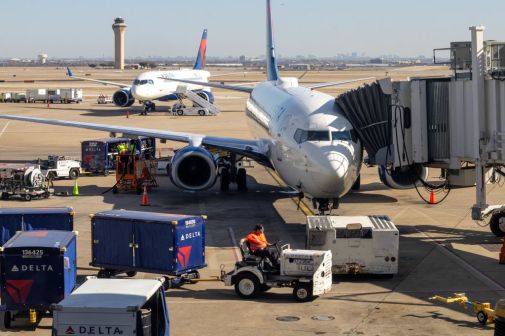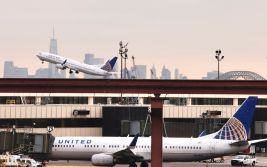Airline industry, controllers call for FAA reorganization
The Federal Aviation Administration has run out of time on its plan to overhaul and modernize the nation’s air traffic control system as far as business executives from the airline industry and the National Air Traffic Controllers Association are concerned.
Just weeks after the National Research Council released a scathing report detailing the lack of progress on the FAA’s $20 billion Next Generation Air Transportation System, known as NextGen, aviation industry representatives and the president of NATCA urged Congress to remove air traffic control responsibilities — along with modernization efforts — from the FAA and give them to an independent nonprofit corporation.
“We cannot continue with the status quo,” Jeff Smisek, president and CEO of United Airlines, said in testimony Tuesday before the Senate Committee on Commerce, Science and Transportation. “Today, all users of the ATC system are beholden to a World War II-era, radar-based system that, while world-class in safety, is inefficient and delay ridden. A long string of reports … has found that the FAA’s progress in delivering NextGen capabilities has not met expectations, calling into serious question the agency’s ability to deliver on its mission under the existing funding and governance structure. It’s the funding and governance structure that we must fix.”
Smisek — who’s also a board member of Airlines For America, an association of 12 leading airlines — said all but one of AFA’s member companies would like Congress to remove air traffic control operations from the FAA and form of a nonprofit corporation to operate the ATC system.
“The FAA could then turn its attention to what it does best — safety regulation and oversight,” Smisek said. “What we know is what we have today does not work. If we keep doing the same thing that we’ve been doing all these years and expect a different result, we will get what we deserve.”
Paul Rinaldi, president of the National Air Traffic Controllers Association, agreed and said it was time for a structural change to the way FAA does business. Many other nations, such as Canada, have already removed air traffic control responsibilities from their regulatory agencies and have deployed modern technologies faster, improved service and reduced costs, he said.
“We understand that addressing the stop-and-go funding problems will lead to an examination of a potential structural change for the FAA. We believe it’s time for a structural change,” Rinaldi said. “The current system is not dynamic enough to address the needs of air traffic control operations in the future.”
John Engler, president of Business Roundtable, echoed the conclusions of the recently released study by the National Research Council, arguing that the FAA has bungled the deployment of NextGen and that the program no longer resembles the original vision.
“The original vision for NextGen is not what is being implemented today. Airlines are not motivated to spend money on equipment and training for NextGen,” Engler said. “The FAA is trying to fund a $20 billion capital modernization effort out of annual and unpredictable cash flow. Most other transportation sectors issue long-term revenue bonds to finance large capital modernization. But bonding is something the FAA cannot do. States do it, the private sector does it, but the federal government does not.”
A panel of experts convened by the Business Roundtable suggested separating the air traffic control operators from the FAA to improve transparency and accountability. “Separating air traffic control into an entity independent from the rest of the FAA is a manageable process,” Engler said.
Lawmakers open to the idea
Committee Chairman John Thune, R-S.D., acknowledged that federal budget pressures have played a significant role in the FAA’s modernization shortfalls, but he said they do not explain all of NextGen’s delays.

An air traffic controller looking at an En Route Automation Modernization, or ERAM, display. (FAA)
“We must carefully consider if there’s a better way to deliver ATC services for the traveling public. And I’m open to considering all ideas,” Thune said.
Ranking member Sen. Bill Nelson, D-Fla., said the answer to the FAA’s problems is not privatization but repealing sequestration and obtaining budgetary certainty for the agency.
“The FAA has faced unpredictability for too long. The last FAA bill took four years and involved 23 extensions and a partial FAA shutdown,” Nelson said. “This has set the FAA back in its progress to advance air traffic control modernization.”
Those who generally oppose an FAA reorganization do so out of concerns about maintaining safety. Rinaldi, for example, said the only structure NATCA would oppose would be a separate for-profit organization to manage air traffic control. That would make oversight and regulation more difficult for FAA and could jeopardize transparency and safety, he said.
The FAA has been operating under a $63 billion funding bill passed in 2012. That funding is scheduled to run out this year, five years short of the 2020 deadline for aircraft operators to install NextGen-compatible avionics on aircraft. The deadline was established by the 2012 FAA Reauthorization Act.
FAA Administrator Michael Huerta said despite the delays, NextGen has had positive effects across the national airspace, saving the airline industry more than $1.6 billion so far and a projected $11 billion over the next 15 years.
New satellite-based systems and data communications capabilities have also allowed the FAA to reduce separation between arriving flights, Huerta said. At Atlanta’s Hartsfield-Jackson International Airport, for example, the number of planes that can land has increased by five planes per hour, he said. Likewise, Huerta said, Delta Air Lines has reduced the taxi time of every flight by two minutes, saving the airline up to $18 million a year.
Earlier this month, the FAA officially launched its new air traffic control system that manages high-altitude flights between its 20 regional centers and forms the technological foundation of NextGen. Called the En Route Automation Modernization, or ERAM, system, FAA officials said the $2.5 billion program will improve air traffic controllers’ visibility of aircraft across the country, and will save time and fuel by allowing aircraft to fly more direct routes at closer intervals.






